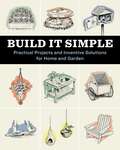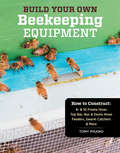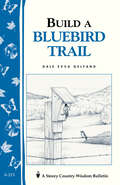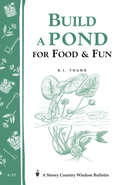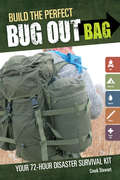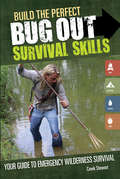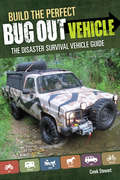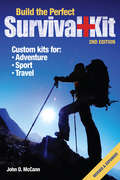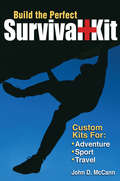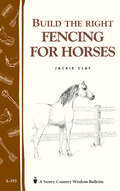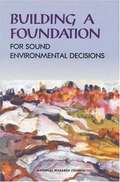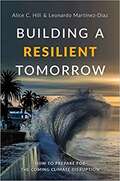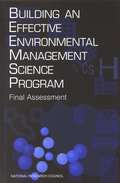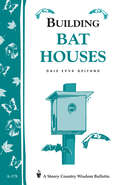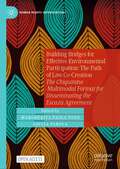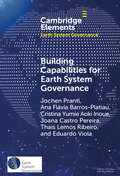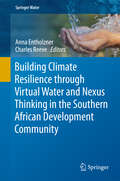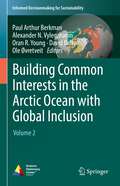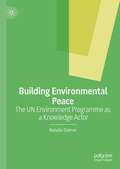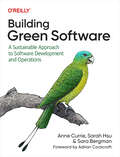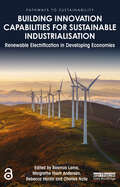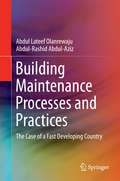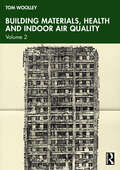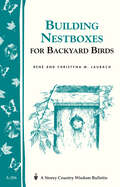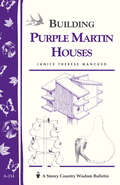- Table View
- List View
Build It Simple: Practical Projects and Inventive Solutions for Home and Garden
by How-To Experts at Storey PublishingDiscover 50 simple, thrifty, low-tech projects that you can create, even if you're a novice builder! With simple tools and materials and just basic building skills, you can make exactly what you need for all of your backyard and gardening projects, from a tool shed and storage bins to lawn chairs, fences, plant supports, and feeders for your chickens. These sustainable, timeless designs, paired with step-by-step instructions and resourceful tips provide a wealth of ideas for a practical and purposeful garden and home. This publication conforms to the EPUB Accessibility specification at WCAG 2.0 Level AA.
Build Your Own Beekeeping Equipment: How to Construct 8- & 10-Frame Hives; Top Bar, Nuc & Demo Hives; Feeders, Swarm Catchers & More
by Tony PisanoSave time and money by building your own beekeeping equipment. Learn to craft equipment that is tailored to your particular climate and setup. Full of insightful tips and covering a variety of hive types, Pisano includes all the basic infrastructure you need to keep your bees happy and active — and your pantry full of honey.
Build a Bluebird Trail: Storey's Country Wisdom Bulletin A-213
by Dale Evva GelfandConservationists across North America are working to help protect and support bluebirds, and you can do your part by creating a bluebird trail. This is simply a series of nesting boxes (anywhere from a few to a few thousand) set about 300 feet apart along a prescribed route. Dale Gelfand tells you what you need to know about bluebirds and their habits, and she shows you how to create and monitor an effective bluebird trail with well-designed nesting boxes.
Build a Pond for Food & Fun: Storey's Country Wisdom Bulletin A-19 (Storey Country Wisdom Bulletin Ser.)
by D. J. YoungSince 1973, Storey's Country Wisdom Bulletins have offered practical, hands-on instructions designed to help readers master dozens of country living skills quickly and easily. There are now more than 170 titles in this series, and their remarkable popularity reflects the common desire of country and city dwellers alike to cultivate personal independence in everyday life.
Build the Perfect Bug Out Bag: Your 72-Hour Disaster Survival Kit
by Jacqueline Musser Creek StewartBe Ready When Disaster Strikes If an unexpected emergency or disaster hits, are you prepared to leave your home--fast? You will be if you follow the advice in this book. This book shows you how to create a self-contained disaster preparedness kit to help you survive your journey from ground zero to a safer location. Survival expert Creek Stewart details from start to finish everything you need to gather for 72 hours of independent survival--water, food, protection, shelter, survival tools, and so much more. You'll find: A complete Bug Out Bag checklist that tells you exactly what to pack based on your survival skill level Photos and explanations of every item you need in your bag Resource lists to help you find and purchase gear Practice exercises that teach you how to use almost everything in your bag Demonstrations for multi-use items that save pack space and weight Specific gear recommendations for common disasters The book even includes special considerations for bugging out with children, the elderly, the physically disabled, and even pets. A disaster could strike your home at any moment. Are you prepared to face the devastating aftermath? Protect yourself and your family by building a Bug Out Bag today!
Build the Perfect Bug Out Survival Skills: Your Guide to Emergency Wilderness Survival
by Creek StewartLEARN HOW TO SURVIVE!When it comes to surviving a disaster, having survival skills and know-how is as essential as having the necessary survival gear. Without the right knowledge, survival gear is useless. Build the Perfect Bug Out Survival Skills will teach you the essential wilderness survival skills you need to endure a bug out situation or prolonged off-grid scenario. You will learn how to meet the four core survival needs - shelter, fire, water and food - with a minimum amount of equipment. Detailed photos and step-by-step instructions will help you master each skill.FEATURING:Detailed instructions for survival skills that require little gear - an emphasis on primitive toolsStep-by-step photos that clearly illustrate complex techniques like knot tying, shelter construction, fire building and setting snares and trapsAdvanced knowledge that could save you and your family during a real emergency
Build the Perfect Bug Out Vehicle: The Disaster Survival Vehicle Guide
by Creek StewartOutfit a Disaster-Escape Vehicle! If an unexpected disaster forces you to suddenly evacuate from your home, is your vehicle equipped to drive you to safety? It will be if you follow the advice in this book. Build the Perfect Bug Out Vehicle shows you how to outfit any vehicle with equipment and survival gear that will help you quickly drive from ground zero to a safer location. Survival expert Creek Stewart, author of the best-selling Build the Perfect Bug Out Bag, details from start to finish everything you need to equip an everyday vehicle for a drive through and away from disaster-stricken areas--from survival supplies and storage solutions to off-road travel, communication, navigation, and security considerations. You'll find: Practical and affordable Bug Out Vehicle equipment and principles that can be applied to any vehicle, even your everyday family car Photos and explanations of every item you need for your vehicle Resource lists to help you find and purchase gear You'll also find special considerations for bugging out using alternative modes of transportation including bicycles, boats, ATVS, motorcycles, horses, carts, aircraft and more. A disaster could strike your home at any moment. Don't be trapped in the devastating aftermath. Quickly transport yourself and your family to safety by building a Bug Out Vehicle today!
Build the Perfect Survival Kit
by John D. MccannYour Kit, Your Survival When an unexpected emergency situation rears its ugly head, will you be up to the challenge? "I wasn't prepared for that!" will no longer be a valid response with the survival-kit-building methods in this book from survival expert John McCann. This fully revised and expanded second edition includes all new information for building bug out bags, get-home bags and vehicle kits that are fully customized to meet your family's specific survival needs. Inside you'll find: Advice for building complete kits that include: fire and light sources, signaling equipment, water and food, shelter and protection, knives and tools, first aid items, and multi-purpose and miscellaneous gear. Hundreds of detailed photos and gear description of essential kit components. Sample packing lists for kits of all sizes and functions. Survival tips and skills that prepare you for emergency survival situations. This book makes building the perfect kit a straightforward and manageable task--no matter what your activity. It is a must for anyone who ventures outside the home. Armed with the kit-building techniques found within, you will be prepared to survive!
Build the Perfect Survival Kit: Custom Kits for Adventure, Sport, Travel
by John MccannAn emergency can arise anytime. Now everyone from the average commuter to the risk-taking sportsman can benefit from these just-in-case kits that may just save a life. Build the Perfect Survival Kit offers a number of kits, from very basic pocket-sized ones with just the essentials to elaborate ones designed for weeks of surviving in the wilderness. The book advocates careful advance planning and building a personalized kit specifically tailored to each outing or possible emergency that may be encountered. Readers will learn about the eight categories of gear: Fire and Light, Signaling, Water and Food, Shelter and Protection, Knives and Tools, Multi-purpose Items and Miscellaneous Items, and what to pack into a kit for their pocket, glove box, four-wheeler, trunk, small plane, backpack, and more. ·Each kit is described with a list of components, a picture of the finished product, and a discussion of each component and its value ·Gives instructions on how to use each component ·Not just for hardcore outdoorsmen - this is valuable information for anyone who drives a car, walks in the woods, etc.
Build the Right Fencing for Horses: Storey's Country Wisdom Bulletin A-193 (Country Wisdom Bulletin Ser. #Vol. 193)
by Jackie ClaySince 1973, Storey's Country Wisdom Bulletins have offered practical, hands-on instructions designed to help readers master dozens of country living skills quickly and easily. There are now more than 170 titles in this series, and their remarkable popularity reflects the common desire of country and city dwellers alike to cultivate personal independence in everyday life.
Building A Foundation For Sound Environmental Decisions
by Committee on Research Opportunities Priorities For EpaOver the past decades, environmental problems have attracted enormous attention and public concern. Many actions have been taken by the U.S. Environmental Protection Agency and others to protect human health and ecosystems from particular threats. Despite some successes, many problems remain unsolved and new ones are emerging. Increasing population and related pressures, combined with a realization of the interconnectedness and complexity of environmental systems, present new challenges to policymakers and regulators.Scientific research has played, and will continue to play, an essential part in solving environmental problems. Decisions based on incorrect or incomplete understanding of environmental systems will not achieve the greatest reduction of risk at the lowest cost.This volume describes a framework for acquiring the knowledge needed both to solve current recognized problems and to be prepared for the kinds of problems likely to emerge in the future. Many case examples are included to illustrate why some environmental control strategies have succeeded where others have fallen short and how we can do better in the future.
Building A Resilient Tomorrow: How To Prepare For The Coming Climate Disruption
by Leonardo Martinez-Diaz Alice C. HillClimate change impacts-more heat, drought, extreme rainfall, and stronger storms-have already harmed communities around the globe. Even if the world could cut its carbon emissions to zero tomorrow, further significant global climate change is now inevitable. Although we cannot tell with certainty how much average global temperatures will rise, we do know that the warming we have experienced to date has caused significant losses, and that the failure to prepare for the consequences of further warming may prove to be staggering. Building a Resilient Tomorrow does not dwell on overhyped descriptions of apocalyptic climate scenarios, nor does it travel down well-trodden paths surrounding the politics of reducing carbon emissions. Instead, it starts with two central facts: climate impacts will continue to occur, and we can make changes now to mitigate their effects. While squarely confronting the scale of the risks we face, this pragmatic guide focuses on solutions-some gradual and some more revolutionary-currently being deployed around the globe. Each chapter presents a thematic lesson for decision-makers and engaged citizens to consider, outlining replicable successes and identifying provocative recommendations to strengthen climate resilience. Between animated discussions of ideas as wide-ranging as managed retreat from coastal hot-zones to biological approaches for resurgent climate-related disease threats, Alice Hill and Leonardo Martinez-Diaz draw on their personal experiences as senior officials in the Obama Administration to tell behind-the-scenes stories of what it really takes to advance progress on these issues. The narrative is dotted with tales of on-the-ground citizenry, from small-town mayors and bankers to generals and engineers, who are chipping away at financial disincentives and bureaucratic hurdles to prepare for life on a warmer planet. For readers exhausted by today's paralyzing debates on yearly "fluke" storms or the existence of climate change, Building a Resilient Tomorrow offers better ways to manage the risks in a warming planet, even as we work to limit global temperature rise.
Building An Effective Environmental Management Science Program: Final Assessment
by Committee on Building an Environmental Management Science ProgramThis book assesses the Department of Energy's Environmental Management Science Program--a new program that funds basic research related to environmental cleanup of the department's weapons complex. The authoring committee was established to advise the department on the structure and management of the program. The book provides recommendations on long-term challenges and opportunities for the program.
Building Bat Houses: Storey's Country Wisdom Bulletin A-178 (Storey Country Wisdom Bulletin Ser.)
by Dale Evva GelfandSince 1973, Storey's Country Wisdom Bulletins have offered practical, hands-on instructions designed to help readers master dozens of country living skills quickly and easily. There are now more than 170 titles in this series, and their remarkable popularity reflects the common desire of country and city dwellers alike to cultivate personal independence in everyday life.
Building Bridges for Effective Environmental Participation: The Chiquitano Multimodal Format for Disseminating the Escazú Agreement (Human Rights Interventions)
by Margherita Paola Poto Giulia ParolaThis open-access book aims to explore and promote indigenous participation in legal design and visual law, with a specific focus on co-creating a visual representation of the Escazu Agreement in collaboration with the Chiquitano people. This project stands out as a unique and transformative endeavor, offering distinctive features and a range of benefits to its readers and stakeholders.
Building Capabilities for Earth System Governance (Elements in Earth System Governance)
by Jochen Prantl Ana Flávia Barros-Platiau Cristina Yumie Inoue Joana Castro Pereira Thais Lemos Ribeiro Eduardo ViolaThis Element develops a new Strategic Capabilities Framework for studying and steering complex socio-ecological systems. It is driven by the central question of what are the most essential capabilities that ought to be fostered for addressing the fundamental 21st Century environmental challenges and Earth system transformations. The author's objective is to innovate transformative ideas toward better climate and ocean governance that are of interest both to academics and policymakers in the field. Rather than investigating the design and effectiveness of institutions in governing the climate and the oceans, the authors offer an alternative approach starting from the assumption that global governance arrangements must be informed by the capabilities of the communities affected. This Element aims to offer out-of-the-box thinking about capabilities-focused and community-centered frameworks that align multi-level systems of governance with the fundamental challenges of global environmental change. This title is also available as Open Access on Cambridge Core.
Building Climate Resilience through Virtual Water and Nexus Thinking in the Southern African Development Community (Springer Water)
by Anna Entholzner Charles ReeveThis book puts the spotlight on Southern Africa, presentinga cutting-edge concept never previously explored in the context of climatechange and putting forward arguments for regional integration and cooperation. The Climate Resilient Infrastructure Development Facility (CRIDF) is the newwater infrastructure program of the UK Department for International Development(DFID) for Southern Africa. The CRIDF promotes the establishment of small tomedium-scale infrastructure across the Southern African Development Community(SADC) through technical assistance aimed at developing sustainable pro-poorprojects, while also facilitating access to the financial resources needed todeliver said infrastructure. Further, it focuses on regional water resourcemanagement goals and basin plans, as well as on building climate resilience forthe beneficiary communities. The Facility's Virtual Water and Nexus Projectworks to improve regional peace dividends by translating the Nexus concept intonational and regional policies; it ultimately promotes sovereign securitythrough greater regional integration across the water, food and energy sectors,while taking into account potential benefits in connection with carbonsequestration and emission mitigation.
Building Common Interests in the Arctic Ocean with Global Inclusion: Volume 2 (Informed Decisionmaking for Sustainability)
by Oran R. Young Paul Arthur Berkman Alexander N. Vylegzhanin David A. Balton Ole Rasmus ØvretveitThis book contains an inclusive compilation of perspectives about the Arctic Ocean with contributions that extend from Indigenous residents and early career scientists to Foreign Ministers, involving perspectives across the spectrum of subnational-national-international jurisdictions. The Arctic Ocean is being transformed with global climate warming into a seasonally ice-free sea, creating challenges as well as opportunities that operate short-to-long term, underscoring the necessity to make informed decisions across a continuum of urgencies from security to sustainability time scales. The Arctic Ocean offers a case study with lessons that are especially profound at this moment when humankind is exposed to a pandemic, awakening a common interest in survival across our globally-interconnected civilization unlike any period since the Second World War. This second volume in the Informed Decisionmaking for Sustainability series reveals that building global inclusion involves common interests to address changes effectively “for the benefit of all on Earth across generations.”
Building Environmental Peace: The UN Environment Programme as a Knowledge Actor
by Natalia DalmerBy analyzing the UN Environment Programme’s (UNEP’s) contribution to peacebuilding, this book aims to show how international bureaucracies develop knowledge and thereby come to matter on the world stage. Portraying UNEP as an open system, it explores how a growing understanding within the Programme of how environmental degradation shapes insecurities and vice versa has motivated its work on peacebuilding. The theoretical part of this book addresses knowledge, open systems, and knowledge creation. It then presents a historical discussion of UNEP’s development in an open system context. Finally, it investigates how knowledge emergence on the linkage between the environment, conflicts, and insecurities influenced UNEP’s interests and its work on environmental peacebuilding.
Building Green Software: A Sustainable Approach to Software Development and Operations
by Anne Currie Sarah Hsu Sara BergmanHow will software development and operations have to change to meet the sustainability and green needs of the planet? And what does that imply for development organizations? In this eye-opening book, sustainable software advocates Anne Currie, Sarah Hsu, and Sara Bergman provide a unique overview of this topic—discussing everything from the likely evolution of national grids to the effect those changes will have on the day-to-day lives of developers.Ideal for everyone from new developers to CTOs, Building Green Software tackles the challenges involved and shows you how to build, host, and operate code in a way that's not only better for the planet but also cheaper and relatively low-risk for your business. Most hyperscale public cloud providers have already committed to net-zero IT operations by 2030. This book shows you how to get on board.You'll explore:How the energy transition is likely to change hosting on prem and in the cloud—and how your company can prepareThe fundamental architectural principles of sustainable software development and how to apply themHow to determine which parts of your system need to changeThe concept of extending hardware longevity and the part that software plays
Building Innovation Capabilities for Sustainable Industrialisation: Renewable Electrification in Developing Economies (Pathways to Sustainability)
by Rasmus Lema, Margrethe Holm Andersen, Rebecca Hanlin and Charles NzilaThis book argues that renewable electrification in developing countries provides important opportunities for local economic development, but new pathways are required for turning these opportunities into successful reality. Building Innovation Capabilities for Sustainable Industrialisation offers a novel input into the debate on development of capabilities for sustainable industrialisation and delivers key insights for both researchers and policy makers when it comes to the question of how to increase the economic co-benefits of renewables expansion. The chapters in the book use a tailored analytical framework in their studies of renewable electrification efforts in Kenya and other countries in sub-Saharan Africa. They draw on a mix of project, sector and country level case studies to address questions such as: What capabilities are developed through on-going renewable electrification projects in developing economies? How can the expansion of renewable electrification be supported in a way that also encourages sustainable economic development? What role do international linkages (South-South and North-South) play and what role should they play in the greening of energy systems in developing economies? The authors provide a new understanding of how green transformation and sustainable industrialisation can be combined, highlighting the opportunities and constraints for local capability building and the scope for local policy action. This book will be of great interest to students and scholars of development studies, energy studies, sustainability and sustainable development, as well as practitioners and policy makers working in development organisations and national governments.
Building Maintenance Processes and Practices: The Case of a Fast Developing Country
by Abdul Lateef Olanrewaju Abdul-Rashid Abdul-AzizThis book is designed to be an inclusive for the best practice approach to building maintenance management, where the processes, procedures and operational systems meet a high standard of professional and academic competence. It offers a different perspective on building maintenance management by presenting the schematic building maintenance value chain model and it's implementation in Malaysian university buildings. The findings show an improvement to building performance, lower maintenance cost, building sustainability and increased maintenance service user satisfaction. The learning outcomes and summaries provided for each chapter and the extensive use of tables and figures add to the readability of the text. Though the book is based on data from Malaysia, it is useful for a much wider audience, and the informal writing style makes it an interesting reference source. This book is valuable for readers who are practitioners, professionals and for academic institutions that offer courses in the building field, including architecture, quantity surveying, civil engineering, building and facility management, property management, real estate. It will also be of interest to governments and others involved in the construction industry.
Building Materials, Health and Indoor Air Quality: Volume 2
by Tom WoolleyIn Building Materials, Health and Indoor Air Quality: Volume 2 Tom Woolley uses new research to continue to advocate for limiting the use of hazardous materials in construction and raise awareness of the links between pollutants found in building materials, poor indoor air quality and health problems. Chapters in this volume reinforce previous arguments and present new ones covering: Further evidence of the health impacts of hazardous emissions from materials Hazardous materials to be avoided and why Fire and smoke toxicity – the Lakanal House and Grenfell Tower legacy Sub-standard retrofits leading to damp and mould in previously sound houses A critical review of recent reports from UK Government and others on air quality and health problems including policy changes on flame retardants Growing evidence of cancer risks and the failure of cancer research organisations to address these issues A critical review of recent climate change and zero carbon policies and a discussion on whether extreme energy efficiency is a good thing This book asks some important and, for some, uncomfortable questions, but in doing so it brings to light important areas for research and provides much needed guidance for architects, engineers, construction professionals, students and researchers on hazardous materials and how to reduce their use and design and build healthier buildings for all occupants.
Building Nest Boxes for Backyard Birds: Storey's Country Wisdom Bulletin A-206 (Storey Country Wisdom Bulletin Ser.)
by Christyna M. Laubach René LaubachThis concise guide offers easy-to-follow, step-by-step instructions for building eight different nestboxes. Each nestbox is designed to attract and house different kinds of backyard birds, including bluebirds, swallows, wrens, chickadees, nuthatches, Red-Bellied Woodpeckers, Northern Flickers, Wood Ducks, Hooded Mergansers, American Kestrals, Screech Owls, Northern Saw-Whet Owls, and Great Crested or Ash-Throated Flycatchers.
Building Purple Martin Houses: Storey's Country Wisdom Bulletin A-214 (Storey Country Wisdom Bulletin Ser.)
by Janice Therese MancusoAttract and maintain a purple martin colony! Janice Mancuso shows you exactly how to do it. From finding the right site and choosing the best housing materials to constructing a martin house with suitable entrance holes and predator guards, you’ll find everything you need to know in this concise guide.
